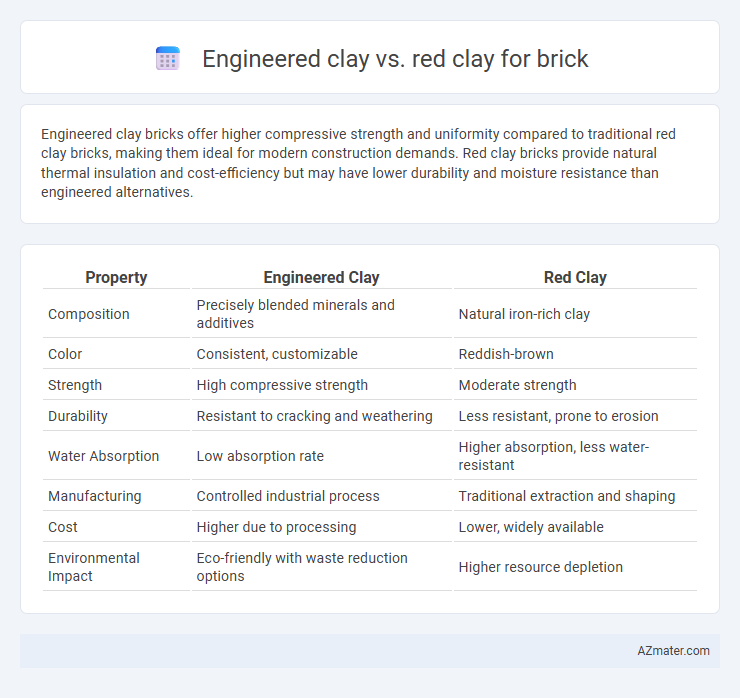Engineered clay bricks offer higher compressive strength and uniformity compared to traditional red clay bricks, making them ideal for modern construction demands. Red clay bricks provide natural thermal insulation and cost-efficiency but may have lower durability and moisture resistance than engineered alternatives.
Table of Comparison
| Property | Engineered Clay | Red Clay |
|---|---|---|
| Composition | Precisely blended minerals and additives | Natural iron-rich clay |
| Color | Consistent, customizable | Reddish-brown |
| Strength | High compressive strength | Moderate strength |
| Durability | Resistant to cracking and weathering | Less resistant, prone to erosion |
| Water Absorption | Low absorption rate | Higher absorption, less water-resistant |
| Manufacturing | Controlled industrial process | Traditional extraction and shaping |
| Cost | Higher due to processing | Lower, widely available |
| Environmental Impact | Eco-friendly with waste reduction options | Higher resource depletion |
Overview of Engineered Clay and Red Clay
Engineered clay bricks are manufactured using a controlled mixture of natural clays and additives, offering enhanced strength, uniformity, and durability compared to traditional red clay bricks. Red clay bricks, made from natural red clay soil, provide good thermal insulation and are widely used for their cost-effectiveness and traditional aesthetic appeal. The choice between engineered and red clay bricks depends on structural requirements, desired finish, and environmental factors.
Composition Differences Between Engineered and Red Clay
Engineered clay bricks are manufactured using a precise blend of natural clay, shale, and additives like fly ash or cement, resulting in uniformity and enhanced strength. Red clay bricks primarily consist of natural iron oxide-rich clay, giving them their distinctive color but variable composition and properties. The controlled composition in engineered clay ensures consistent density and durability, whereas red clay varies based on regional soil characteristics and firing techniques.
Manufacturing Process Comparison
Engineered clay bricks are produced using precisely controlled composition and advanced drying and firing techniques, resulting in uniform density and enhanced durability. Red clay bricks are traditionally manufactured by molding natural clay and firing it in kilns, which can lead to variable quality due to inconsistent raw material properties and firing temperatures. The engineered clay process incorporates additives and mechanized systems that optimize water content and firing times, improving strength and reducing porosity compared to conventional red clay brick production.
Physical Properties of Engineered Clay Bricks
Engineered clay bricks exhibit superior physical properties compared to red clay bricks, including higher compressive strength, reduced water absorption rates, and enhanced durability against weathering and chemical attack. Their uniform particle size and controlled firing process result in consistent density and enhanced structural integrity, making them ideal for load-bearing applications. Additionally, engineered clay bricks offer better thermal insulation and improved resistance to abrasion, contributing to longer lifespan and reduced maintenance costs.
Physical Properties of Red Clay Bricks
Red clay bricks exhibit high compressive strength ranging from 10 to 20 MPa, making them suitable for load-bearing structures. Their porosity varies between 10% and 20%, affecting water absorption rates typically around 15-20%, which influences durability in moist environments. Red clay bricks possess good thermal insulation and moderate density, usually around 1800-2000 kg/m3, contributing to stable indoor temperatures and structural integrity.
Strength and Durability Analysis
Engineered clay bricks exhibit superior compressive strength and enhanced durability compared to traditional red clay bricks due to controlled raw material composition and advanced manufacturing processes. Red clay bricks typically have lower strength, around 3.5-7 MPa, while engineered clay bricks can achieve strengths exceeding 20 MPa, making them more resistant to weathering and mechanical stress. The optimized mineral content and firing techniques in engineered clay result in denser microstructures, reducing porosity and increasing resistance to moisture absorption and freeze-thaw cycles.
Thermal and Acoustic Insulation Performance
Engineered clay bricks exhibit superior thermal insulation properties due to their controlled porosity and uniform composition, effectively reducing heat transfer compared to traditional red clay bricks. Acoustic insulation is also enhanced in engineered clay bricks, as their consistent density and microstructure absorb sound waves more efficiently, minimizing noise transmission. Red clay bricks, while durable and widely used, tend to have higher thermal conductivity and less sound absorption, making them less effective for energy efficiency and noise control in construction.
Environmental Impact and Sustainability
Engineered clay bricks demonstrate lower environmental impact compared to red clay bricks due to their optimized manufacturing process that reduces energy consumption and raw material waste. Red clay bricks, traditionally kiln-fired using fossil fuels, contribute higher carbon emissions and lead to significant soil depletion and deforestation. Sustainable construction increasingly favors engineered clay bricks for their recyclability and reduced ecological footprint in brick production.
Cost Efficiency and Economic Considerations
Engineered clay bricks offer greater cost efficiency due to consistent quality, reduced waste, and faster production processes compared to traditional red clay bricks. While red clay bricks have lower initial material costs, the variability in raw material quality often leads to higher labor and maintenance expenses over time. Investing in engineered clay bricks provides long-term economic benefits through enhanced durability and energy savings during construction.
Best Applications for Engineered and Red Clay Bricks
Engineered clay bricks offer superior uniformity, strength, and water resistance, making them ideal for high-load structural walls, modern architectural facades, and areas exposed to harsh weather conditions. Red clay bricks, with their natural porosity and thermal insulation properties, are best suited for traditional construction, interior partitions, and decorative applications where breathability and aesthetic warmth are prioritized. Choosing between engineered and red clay bricks depends on specific project requirements, such as durability, environmental exposure, and design preferences.

Infographic: Engineered clay vs Red clay for Brick
 azmater.com
azmater.com